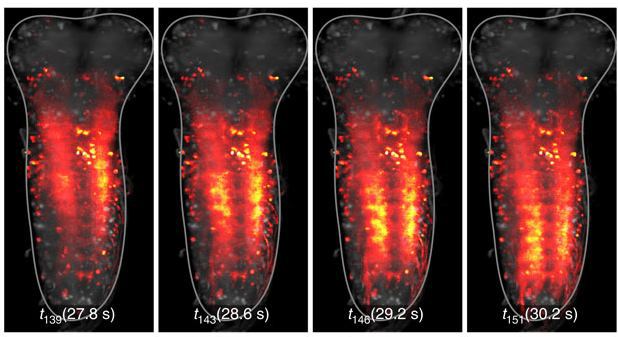Scientists taped the fruit fly's nervous system

The nervous system of not only humans, but also organisms, including insects, is a very difficult object to study. Despite decades of research, scientists still don't fully understand how it all works. Nevertheless, one can believe that the solution is already close.
Whatever it was, but the experts at Howard Hughes Medical Institute managed to film the work of the central nervous system of Drosophila, the fruit fly. Scientists published the results of the work in the authoritative journal Nature .
In their project, scientists did not work with an adult insect (imago), but with its larva. The video clearly shows how various sections of the nervous system of the larva are activated when it makes movements. According to experts, this project will help to understand how various parts of the larval nervous system interact, including the brain ganglion and spinal cord. Scientists also hope to create a model of processes occurring in the nervous system of the larva.
In order to get a glow, the authors had to immediately modify the DNA of the body, ensuring that the neurons began to synthesize a fluorescent protein when the corresponding electrical impulses passed through the tissue. Scientists conducted observations using microscopy of planar illumination, where a laser is used to obtain an optical section in a place with fluorescent molecules.
As it turned out, just such a method is most effective in this case. Soon, scientists are going to start work with other organisms, including the adults of Drosophila, fish and small rodent embryos (mainly mice), in the early stages of development.
By the way, several groups of scientists continue to study such an organism as a nematode ( Caenorhabditis elegans) This is the most studied organism on Earth, and the adult individual consists of 959 cells, and the individual's nervous system consists of 302 neurons. Therefore , the idea arose to create a virtual nematode model.
For a project to study and digitize this living organism, funds were even raised on Kickstarter . Now the project is at one of the stages of implementation, and scientists from Italy, Spain, Russia, Portugal and Germany are participating in it.
Interestingly, the scientists still managed to describe the work and connections between all 302 neurons of the worm’s brain, as well as simulate the work of the brain in a digital model. Scientists placed a digital model in a robot from Lego Mindstorms EV3 (a review of it on Geeks), all of whose elements have their analogues in the body of a real worm. So, the sonar here replaced the nose of the worm, and the servos - motor neurons in each part of the body of the worm.
It is worth noting that the brain simulation is still not complete - the scientists used some simplifications and approximations to launch a digital copy in the foreseeable time. But the fact is that even such a simplified copy was able to protect the robot from collision with obstacles (without additional instructions in the program). In addition, the robot was able to independently choose the direction of movement, which can also be called a significant achievement.
